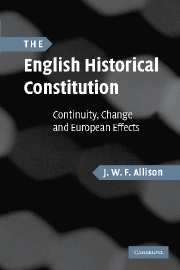Book contents
- Frontmatter
- Contents
- Table of Cases
- Preface
- 1 Introduction
- 2 A historical constitutional approach
- 3 The Crown: evolution through institutional change and conservation
- 4 The separation of powers as a customary practice
- 5 Parliamentary sovereignty and the European Community: the economy of the common law
- 6 The brief rule of a controlling common law
- 7 Dicey's progressive and reactionary rule of law
- 8 Beyond Dicey
- Conclusions and implications
- Bibliography
- Index
3 - The Crown: evolution through institutional change and conservation
Published online by Cambridge University Press: 18 December 2009
- Frontmatter
- Contents
- Table of Cases
- Preface
- 1 Introduction
- 2 A historical constitutional approach
- 3 The Crown: evolution through institutional change and conservation
- 4 The separation of powers as a customary practice
- 5 Parliamentary sovereignty and the European Community: the economy of the common law
- 6 The brief rule of a controlling common law
- 7 Dicey's progressive and reactionary rule of law
- 8 Beyond Dicey
- Conclusions and implications
- Bibliography
- Index
Summary
The Crown's central significance and its continuing conceptual obscurity or incoherence are commonplace in English literature on the constitution. In Law of the Constitution, Dicey used the vast powers ascribed to the Crown, but not actually exercised by it, to illustrate the ‘unreality’ of the lawyer's view of the constitution and ‘the hopeless confusion, both of language and of thought’ that resulted and to which his own analytical approach was, in part, a response. In their reassessment, Sunkin and Payne rightly emphasise that while ‘the Crown may be at the heart of the constitution, the nature of the Crown and its powers remain shrouded in uncertainty and continue to generate controversy’. The result is a paradox. The institutional centrepiece of the constitution remains poorly understood and inadequately analysed. If this central paradox is inexplicable, English constitutional analysis or theory may well be dismissed as an oxymoron, or the constitution itself, as a puzzle, mystery or mere muddle. Explaining the Crown is confounded further by another paradox. The traditional conception of the Crown as a corporation sole has been attributed simultaneously to the Romans and ‘the … genius of the English nation’. At least in its origins, the conception of the Crown would seem both peculiarly English and Continental European.
In this chapter, I will seek to explain the Crown's central significance and reduce its paradoxical obscurity and peculiarity by taking the historical constitutional approach described in the last chapter.
- Type
- Chapter
- Information
- The English Historical ConstitutionContinuity, Change and European Effects, pp. 46 - 73Publisher: Cambridge University PressPrint publication year: 2007



